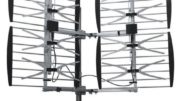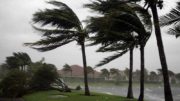There are some of you… not many, but some… who will need to put a large antenna up on the roof in order to get local channels. How large? Think of the antennas you saw on roofs growing up. That large. Even though most people can make do with something much smaller, there are some areas where a big antenna is a must.
Why does this still happen?
Yes, the digital TV transition was supposed to fix all this. TV broadcasting should have left the so-called “VHF-Low” band that includes channels 2,3,4,5, and 6. In fact at one point the hope was that all channels would go to UHF, meaning smaller and more efficient antennas for everyone. There are still a lot of VHF stations out there, but at least most have moved to the “VHF-High” band of channels 7-13 where a smaller antenna can be used.
So what’s the problem?
The lower channels need a larger antenna because as you get into those lower frequencies, the waves themselves get longer, and a longer wave needs a longer antenna. In fact that’s sort of the key part of antenna design — there’s a very precise relationship between the broadcast frequency and the length of antenna that receives it best. As wavelengths get shorter, it gets easier and easier to have one antenna that does a good job for more frequencies, which is why UHF antennas can be very compact.
A little research led to a list (accurate as far as I know) of markets with VHF-Low channels. Here’s what it boils down to:
-
There are 56 markets with one VHF-Low station. Although this is roughly double the number that there were five years ago, there aren’t any markets with more than one network affiliate on VHF-Low.
-
There’s a pretty big spread in the kinds of cities with VHF-Low channels. Los Angeles has one, so do Chicago, Boston and Philadelphia. And on the other side, you’ll find Altoona PA, Miles City MT, and Manchester VT on that list.
-
The biggest market with a “must-have” VHF-Low antenna is Philadelphia. WPVI Channel 6 has been broadcasting on the same frequency since it signed on and stubbornly refuses to change.
Of course this doesn’t mean that some of these channels aren’t important. Only you can decide this. Some are public broadcasting channels, others are non-English. If these are important to you, then you’ll need that big antenna if you’re more than a few miles from the center of the city.
What can you do?
If you are in one of these VHF-Low markets, you have a bit of a challenge ahead of you if you want to cut the cord. If you’re in the city center, you’ll probably be able to pick up the channel you want no matter what antenna you use. Out in the suburbs you’ll have to rely on one of those old-school Yagi antennas like you see at the top of this article. It doesn’t have to be the massive 8200XL, but you will need something that’s optimized for VHF-Low frequencies.
In the past, I would have recommended you put up a separate VHF-Low antenna. In recent years those have become pretty hard to find. Really your best option is going to be the bigger antenna. Smaller antennas with a lot of amplification “might” pick up those channels but it’s not a sure bet. Unfortunately this is one of those times. What I mean is… “size matters” and there’s “no substitute for cubic inches.” Those sayings might not hold up in other areas, but when it comes to VHF-Low antennas, they sure do.
If you’re not sure about which antenna to purchase, ask your friends at Solid Signal! We have a free service which will choose the right antenna or antennas for your area!





